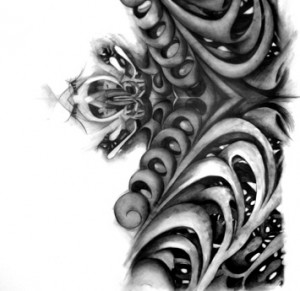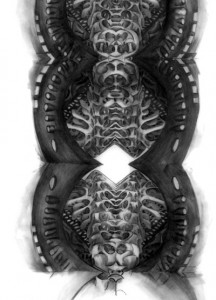Elizabeth Turk, a native Californian born in Pasadena in 1961, received her B.A. in International Relations from Scripps College in 1983. Turk then went on to pursue a Masters in Fine Arts from Rinehart School of Sculpture at the Maryland Institute in Baltimore. In the mid 1990s, Turk began working with marble while living in New York. Turk left New York in 2001, returning to Southern California as the Artist in Residence at California State University Fullerton. In that same year, Turk met Richard Chiarini who with his brother, George, owns Chiarni Marble & Stone, a company that creates architectural carvings for homes and businesses. Chiarini, whose company has unofficially sponsored dozens of fine artists in the past, providing free workspace, tools and cutting and moving services, invited Turk to come work at their company site in Santa Ana, California. Turk carved her series of delicate sculptures, “The Collars,” on the Chiarni site and is currently working on a new series inspired by water.
Turk has received several awards and residencies including, in 2000, the Joan Mitchell Foundation Grant and New York City Art Commission Award for Excellence in Design and, in 2001, the L’Oreal Art and Science Prize for her collaboration with Kirara Kawachi in Japan. In 2002, Turk served in the Kyojima Artist in Residency Program in Tokyo and in 2003, Turk worked as the Artist in Residence at the McColl Center for Visual Art in Charlotte, North Carolina. In Charlotte, Turk drew from works in the Mint Museum of Art’s historic collections of lace and antique lace collars, contributing to the study for her series, “The Collars.” She exhibited a selection of these in 2003 in “Matter and Matrix” at the Ruth Chandler Williamson Gallery at Scripps, and again in 2004-2005 at the Mint Museum in “Vantage Point III Elizabeth Turk — The Collars: Tracings of Thought.” The series was displayed in its entirety at the 2006 Hirschl & Adler Modern exhibit entitled “The Collars.”
Elizabethan ruffs, the intricate patterns of lace, as well as natural and corporal imagery, from spider webs to the human skeletal system, were the inspiration for the delicately carved and intricately designed collars, each sculpted from a 400-pound block of Sivec or Carrara marble. These scientific yet natural studies serve as representations of articles of clothing and hold symbolic meaning. The structure and organization of the pieces, in particular Collars #7 and #8, were Turk’s responses to the events of 9/11 and demonstrate “the fragility of life manifested in the hardness and stability of the marble.”
During her residency at the McColl Center for Visual Arts, Turk also produced the graphite on vellum (a translucent parchment) drawings, Untitled #1, #4, #5, #7, now a part of the Ruth Chandler Williamson Gallery’s permanent collection. These drawings served as preparation for the 2003 Ruth Chandler Williamson Gallery’s exhibition, “Matter and Matrix.” To produce the intricate design of the drawings, Turk drew from a combination of forms she manipulated using Photoshop. Untitled #1, with its vertebral and plantlike design, clearly complements her sculpted collars. This piece, currently hanging in the Alexa Fullerton Hampton Room of Malott Commons, provides the Scripps community with a visual taste of Turk’s “delicately monumental” collar sculptures.
Written by Megan Downing (SC ’08), 2007-08 Academic Year Wilson Intern.



